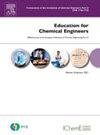如何使用电子表格轻松地向化学工程师教授频率响应
IF 2.3
2区 教育学
Q1 EDUCATION, SCIENTIFIC DISCIPLINES
引用次数: 0
摘要
化学工程过程动力学教师最具争议的问题之一是频率响应工具的扩展和方法。在化学过程中,时间常数通常从秒到天不等,即与其他工程专业人员(例如电气工程师,其时间常数在毫微秒范围内)所面临的几个数量级不同。这意味着用于化学工程师的频率响应技术教学的方法必须与其他学位的教学方法非常不同,这一事实在学习计划中并不总是被考虑到。这篇文章描述了基于案例研究的模拟学习(SCSBL)方法,该方法已经在卡斯蒂利亚-拉曼查大学成功应用了二十多年,使用Visual Basic for Excel开发的模拟工具。通过这个工具,学生获得必要的技能,以一种实用的方式建立一个模拟器,从这个模拟器中,与其他传统方法相比,系统的频率响应在相当短的时间内得到评估。这使学生不仅对频率响应的主要概念有一个清晰的认识,而且能够对任何系统进行频率响应研究并得出相关结论。本文章由计算机程序翻译,如有差异,请以英文原文为准。
How to teach frequency response easily to chemical engineers using spreadsheets
One of the most controversial points for teachers of Process Dynamics in Chemical Engineering is related to the extension and methodology for the frequency-response tools. In chemical processes, time constants typically range from seconds to days, i.e. several orders of magnitude different from those faced by other engineering professionals (e.g. electrical engineers, where time constants are in the milli-microsecond range). This means that the approach used for the teaching of frequency-response techniques for Chemical Engineers must be very different from that of other degrees, fact that is not always considered in the study programs. This contribution describes the Simulation Case Study-Based Learning (SCSBL) methodology, which has been successfully employed at the University of Castilla-La Mancha for over two decades using simulation tools developed in Visual Basic for Excel. Through this tool, the student acquires the necessary skills to build a simulator in a practical way from which the frequency-response of a system is evaluated in a time considerably less compared with other traditional methodologies. This allows the student to have a clear understanding not only of the main concepts of frequency response, but also to be able to perform a frequency response study of any system and draw relevant conclusions.
求助全文
通过发布文献求助,成功后即可免费获取论文全文。
去求助
来源期刊

Education for Chemical Engineers
Multiple-
CiteScore
8.80
自引率
17.90%
发文量
30
审稿时长
31 days
期刊介绍:
Education for Chemical Engineers was launched in 2006 with a remit to publisheducation research papers, resource reviews and teaching and learning notes. ECE is targeted at chemical engineering academics and educators, discussing the ongoingchanges and development in chemical engineering education. This international title publishes papers from around the world, creating a global network of chemical engineering academics. Papers demonstrating how educational research results can be applied to chemical engineering education are particularly welcome, as are the accounts of research work that brings new perspectives to established principles, highlighting unsolved problems or indicating direction for future research relevant to chemical engineering education. Core topic areas: -Assessment- Accreditation- Curriculum development and transformation- Design- Diversity- Distance education-- E-learning Entrepreneurship programs- Industry-academic linkages- Benchmarking- Lifelong learning- Multidisciplinary programs- Outreach from kindergarten to high school programs- Student recruitment and retention and transition programs- New technology- Problem-based learning- Social responsibility and professionalism- Teamwork- Web-based learning
 求助内容:
求助内容: 应助结果提醒方式:
应助结果提醒方式:


